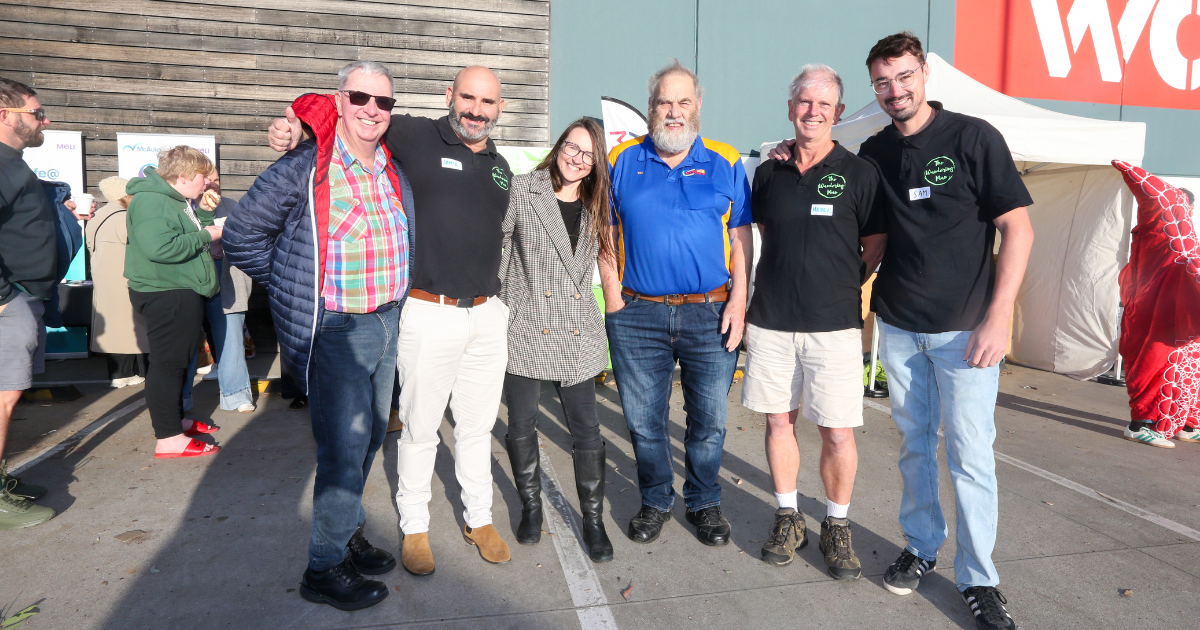Committee for Lorne: The Spotted-Tailed Quoll
I hope, long, and ache to see one … though in a lifetime of hoping, longing, and aching, I have yet to experience that joy.
I sometimes think that the Spotted-tailed Quoll [Dasyurus maculatus] … commonly called the Tiger Quoll … might be a figment of the imagination—like the elusive, mystical, and realistically make-believe Otway Panther. But unlike the panthers, Quolls are out there!
Indeed, Tiger Quolls—known to the Aboriginals as bindulung—do exist right here in the Otways, though their numbers are decreasing. They are officially ‘endangered’ in mainland Australia and are graded as ‘vulnerable’ in Tasmania … see https://tinyurl.com/mr48pyh8
Sadly, the closest I have come to seeing a real live Quoll—apart from a few sad captives hiding away in hollow logs at the Healesville Sanctuary—is the beautiful, small-sculpture Tiger Quoll [sculptor: Simon Normand] that I was lucky enough to purchase at the last Lorne Sculpture Biennale [see pictured].
Though my grandchildren don’t seem to like it … ‘his teeth are too fearsome, Grandad’ … no matter, say I … suck it up, ‘cos I love it.
An excellent place to learn more about Tiger Quolls is the Nature Glenelg Trust website: https://tinyurl.com/3vuwz4em. Much of the following is a synthesis of [or quotes from] this site.
Male Tiger Quolls average ~3kg in weight,though some can weigh more than 8kg. Females are smaller and have one litter of about five pups each year. Of some interest, multiple paternity is common for pups born within the same litter, meaning the female may mate with and be successfully fertilised by several different males in the one oestrous cycle! While we might think that suggests that they are rather ‘promiscuous’, Quolls would likely disagree as their multi-paternity program has proven a helpful ploy to broaden and sustain the gene pool.
Tiger Quolls, solitary and nocturnal, prefer the dense eucalypt forests high in the Otways, and especially along Riley’s Ridge in the upper reaches of the Barham River beyond Paradise [btw: what an apt name]. Since humans rarely travel the back roads of their Otway range at night, this may partly explain the rarity of sightings … moreover, if the glimpse is fleeting, a Quoll may be mistaken for a feral ginger cat unless the spots are clearly seen.
Quolls have quite an extensive range for a small animal—about 800ha for males and about half that for females. Tiger Quolls are adept at climbing and commonly use trees or fallen logs as Quoll thoroughfares to move quickly and silently through the undergrowth. In addition, a hollow log happily doubles as a warm and cosy den.
To adapt Mark Bachmann’s excellent article in Nature Glenelg Trust [see reference above] … ‘as communication within a population of solitary, wide-ranging animals can be difficult, Tiger Quolls use ‘latrines’—communal areas where scat (poo) and scent marks can be left [these ‘markers’ act just like a social media page]—that enable local area Quolls to keep contact with individuals, maintain social cohesion, and benefit reproduction by advertising female sexual receptivity and male presence or dominance’.
A truly remarkable and innovative program has been developed in the Otways [https://tinyurl.com/ypd792t2 ] that deserves the support of all who value the unique Tiger Quoll. Again, to quote Mark Bachmann, the Conservation Dogs program trains dogs and their handlers to search large areas of bush and detect evidence of Quolls without tracking or disturbing the animal itself. These highly trained conservation dogs and their handlers demand our greatest respect, and funding support!
Tiger Quolls are high-level bush predators. They prey on small, broad-foot marsupial mice, native rats, possums, birds, reptiles, a bunch of invertebrates, and European rabbits. The latter have proven a new and exotic fare since the importation and widespread release of bunnies by Thomas Austin in 1859 at nearby Barwon Park, Winchelsea. Perhaps we should wish all strength to the Quoll’s jaw, as a rabbit plague has beset Australia ever since … the epitome of a native ‘catch and munch’ program.
Although Austin is widely held to have introduced rabbits to this previously rabbit-free land, this is not entirely true. Caged rabbits were brought to New South Wales for food by the First Fleet in 1788 … see https://tinyurl.com/36drr5w4 … but were well-contained. However, a similar Tasmanian ‘bunnies for consumption’ program was not as well managed and by 1827, Tasmanian newspapers were reporting that ‘rabbits had escaped into the wild and were running amok’. As a result, Tassie Quolls were able to develop their taste for bunny stew well before their Otway cousins, who were denied the novelle cuisine for a further three decades.
As Tiger Quolls like to nibble on carrion—as do Tasmanian Devils, those other fierce bush predators—one of the surest ways to bump into one in the wild is to catch it in the headlights as it snacks on road-kill beside a bush road. But unlike the Devils in Tasmania, Quolls are nimble and quick and thus generally escape the roadside slaughter meted out to the Devils.
As with so many of our native animals in the Otways—perhaps especially the koala and platypus— habitat loss and fragmentation is the most serious threat to their survival, and this, of course, means us, humans! Though feral cats and foxes pose another risk, especially to young Quolls, as they leave their dens to fend for themselves.
The Nature Glenelg Trust website concludes with a few excellent ‘things to look for’ dot points:
- Spots … if you see a furry creature running around with beautiful white spots all over its body (including its tail), you have likely just spotted a Tiger Quoll.
- Tails … a long tail held horizontally behind a stocky and well-built body running in a bounding overstep pattern.
- Trees … remember that this animal is more than capable of climbing. Don’t forget to look up, too!
By far the most comprehensive description of our Otway Quolls can be found at https://tinyurl.com/4p9cndpd a site I would highly recommend to any who might want to learn more about these most fascinating and beautiful deep-forest animals … animals so unknown to many, but that live in the unique deep forest at our very back door.
John Agar
Feature Writer
A word from the chairman
Hello
I recently read an interview with a young man (26 years old) who suffered severe facial injuries as a result of a freak football accident. He was in an induced coma for 17 days and has lost sight in one eye. The overwhelming sentiment that flowed through the interview was one of gratitude, to the first responders, to the doctors, surgeons and nurses who “rescued” him from his life-threatening injuries, and the extraordinary response of the community that came together to raise over $330,000 to cover his medical bills and ongoing care. He said “One of the themes of my recovery has been gratitude because if I dwelled on it, it would be no good for me”. What a profound attitude in such devastating circumstances!
So much of the unacceptable behaviour we see in society today is based on entitlement rather than gratitude. While as parents we try to teach our children (and grandchildren) to be confident and self-assured, are we developing in them a sense of self-entitlement? This is not helped by the media bombardment of what we can and must have.
Does this lead to an entitlement, a right, to have what others have, and if you can’t afford it to take it, whether it be personal property, liberty or security? The values we as a community should reinforce are courtesy, respect and gratitude. It is just as easy to say “please” and “thank you” as it is to say “I want” or “we demand”.
*****
Once again Lorne comes alive for the Cup “long” weekend. There are lots of activities for those not heading to Flemington, kicking off with the Foreshore Market on Saturday morning. The market is full of artisan goods, fresh foods and refreshments, and is an important fundraiser for our local school, so please come along and support. Our cricketers head to Apollo Bay on Saturday afternoon, hungry for a game and a win after a washout and a forfeit. On Sunday the Aquatic Club will come alive with the sound of the McNaMarr Project, an exciting 6 piece blues and soul band from 4-7pm. On Monday, the Country Club will host its traditional Cup Eve Dinner, and just to finish it off, head to the Aquatic Club on Tuesday for lunch and a quiet punt. Bookings are required for the Cup Eve dinner and the Cup Day lunch but the other events are open and free. No reason to stay home, the garden can wait!
By the way, it was great to see our King and Queen visiting Australia, but someone should have told them that you don’t barbeque in a suit!
Cheers (and good luck if you are having a punt)
Lorne Ward Events Calendar
November
1-10 – Karren Stoneham Art Exhibition, at Lorne Community Connect from 10.30am daily
2 – Lorne Market, 9-3pm https://www.lornemarkets.com/
4 – Lorne Country Club Members & Guest night, Members @$60 and Guests @ $65 – includes 2 horses in our $5.00 sweeps 6-10pm


















